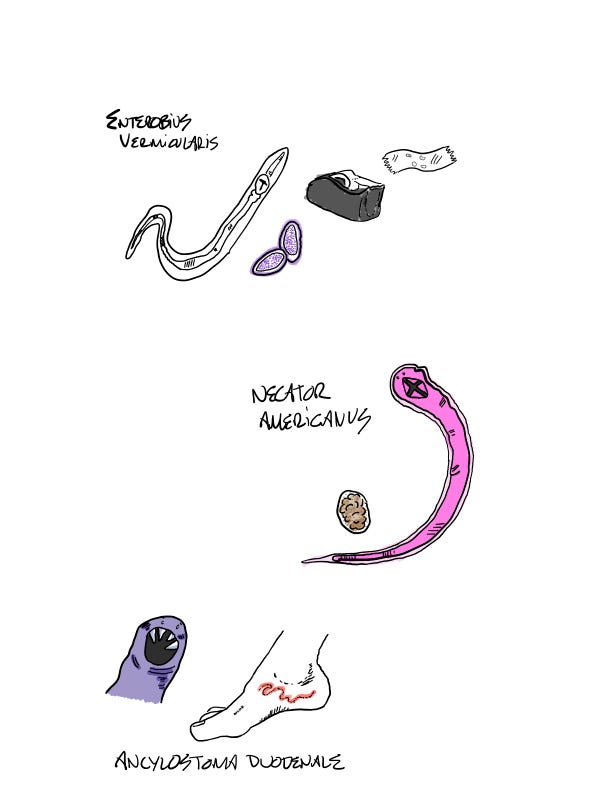Worms have been all over celebrity news lately and there are a lot of TikTok creators who are selling worm “cleanses.” There has also been a recent human infection of screwworms (which are actually parasitic fly larva) in the United States. So should you be worried about getting worms? Worm infections are a huge problem worldwide and cause a massive disease burden. Millions and millions of people are impacted by worms globally; risk factors for intestinal parasite infection include poverty and lack of access to clean water and good sanitation.
There are a lot of worms out there and a lot of false information, so let’s break down what a worm is, how you get infected, and what treatment options are available.
What worms can cause infections?
Your friendly neighborhood earthworm isn’t going to get into your body and cause problems. So what worms are we even talking about when we say someone “has worms”? Worms is the colloquial term for various parasites, most often intestinal/gut parasites. And there are a lot of different intestinal parasites. A few include:
- Pinworms: Pinworms are the common name of a roundworm called Enterobius vermicularis. They’re an extremely common worm all over the world, especially in school-age children. The main symptoms of pinworm infection is itching around the infected person’s anus, especially at night when the pinworm is laying their eggs. When a person who is infected scratches themselves at night, the eggs are then on that person’s skin and they can keep re-infecting themselves if they touch themselves near their mouth. You can test for this with the “tape test” where you collect pinworm eggs around an infected person’s anus with tape. Pinworms are very easy to treat; just remember that two doses of the medication are necessary because the treatment only kills the worms, not the eggs.
- Other Roundworms: Ascaris lumbricoides is a type of roundworm that can ultimately cause a blockage in your gut. It is found primarily in tropical and subtropical regions. You can get infected by interacting with infected soil. The worms can migrate to the liver, the pancreas and bladder and cause problems. Infection is diagnosed via a stool sample. The worms can get to be 35 cm long. You can treat the infection with medication. Most cases in the U.S. occur in the southeast because of the warm climate.
- Hookworms: There are two primary types of hookworms: Ancylostoma duodenaleand Necator americanus. They are also found in tropical and subtropical regions. They’re spread via walking barefoot or having skin-to-soil contact with contaminated soil. You can also get hookworms by drinking water contaminated with poop. Hookworms are primarily found in warm places with sandy soil. They have a pretty interesting lifecycle: They enter the skin of the foot, migrate to the lung, and then down the throat and into the intestines where they hook onto the lining of your gastrointestinal tract. The hookworms then basically drink your blood, often causing anemia. Hookworms can be treated with medications, however, re-infection is likely in places where hookworms are very common.
- Whipworms: Trichuris trichiura is the scientific name for whipworms. Whipworms can be found in soil and water contaminated by human feces, poop. Infection occurs when someone eats something that is contaminated by soil containing worm eggs. These worms are primarily found in tropical areas and can be tested for via stool samples.
- Tapeworms: There are three species of tapeworms but we’ll focus on Taenia solium, which is a type of pork tapeworm. You can get infected with tapeworms from eating raw or undercooked meat. T. solium is particularly scary because the tapeworms can go to the eyes and break causing a disease called neurocysticercosis. This can cause headaches, blindness, convulsions and can ultimately be fatal. These infections can be treated if caught early, but it’s also important to focus on large-scale food safety and sanitation interventions to keep animals from getting infected in the first place. Tapeworms are also a reason why meat inspection is so important. There is also a fish tapeworm called Dibothriocephalus latus which can grow up to thirty feet long inside a person. These worms mostly are found in the Northern Hemisphere and infect freshwater fish. Though infection in the United States is rare, the best way to avoid an infection is to not eat raw or undercooked fish. Freezing fish can also kill the worms and help prevent infection.

⚖️ Health Equity Alert
There are a number of worms that are transmitted through the soil. These include hookworms (Necator americanus and Ancylostoma duodenale), roundworms (Ascaris lumbricoides), and whipworms (Trichuris trichiura). According to the WHO, these worms impact approximately 1.5 billion people, primarily in sub-Saharan Africa, China, and South America. Infection with these worms can cause malnutrition through diarrhea, and anemia. If the worms are not treated and continue to reproduce, intestinal obstruction and even death can occur. Hookworms can cause anemia, which can be especially dangerous for pregnant women and children.
A twenty-year long study showed that treating children who have worms in areas where they are most common decreases absence from school and ultimately helps those children achieve better economic outcomes. Even in the United States, poverty is a huge driver of worm infection. It’s important to talk about the need for adequate sanitation and access to healthcare in areas where worm infections are common. Small public health efforts can make a huge difference in the lives of children all over the world.
What are the symptoms of having worms?
People often don’t have symptoms of a worm infection until there are a lot of worms inside you. Depending on the worm, the symptoms can include: stomach pain, nausea, vomiting, diarrhea, small bowel obstruction, weight loss, iron deficiency, liver abscesses, coughing, fever, itching around your bottom and more. If you have a worm infection, you might have something called “eosinophilia” on your lab work. That means that certain white blood cells, your “infection fighter” cells, are increased. Eosinophils are a type of white blood cell that specifically target organisms like worms. However, you can have increased eosinophils without a worm infection, since allergies can also increase the number of eosinophils in your body.
How do you diagnose worms?
The diagnosis depends on what sort of worm you might have. Most people do not get worms from living in the United States but can get worms from traveling to locations where infections are more common. This is why it’s important to give your clinician a full travel and exposure history so they can run the right tests. Some worms can be seen on ultrasound (like Ascaris), some can be seen in stool specimens, and some can be identified on blood tests (like Strongloides). If you’re concerned about a worm infection, your clinician will ask about your recent travel, places you might have walked barefoot, or about things that you might have eaten recently.
How do you treat worms?
Fortunately, there are a number of different medications that can be prescribed to treat a worm infection, and the drug choice will depend on the type of worm. It is important to keep in mind that while these medications are very effective at eliminating worm infections, they have side effects and should only be taken under the direction of a clinician who diagnosed you. You might see videos about things you can buy yourself to treat worms, but it is important to remember that all medications have side effects and treatments for worms should only be taken under the direction of a diagnosing clinician, and with a prescription.
Social media’s obsession with worms doesn’t touch on the real public health implications of worm infections. Worms are a major problem globally. Global health measures like increased sanitation and oversight of meat and fish processing can go a long way in decreasing the number of people infected with worms. Even in the United States, poverty and lack of sanitation are major contributors to intestinal worm infections. For many people in the United States, everyday hygiene and food safety keep the risk relatively low.
Further reading:


